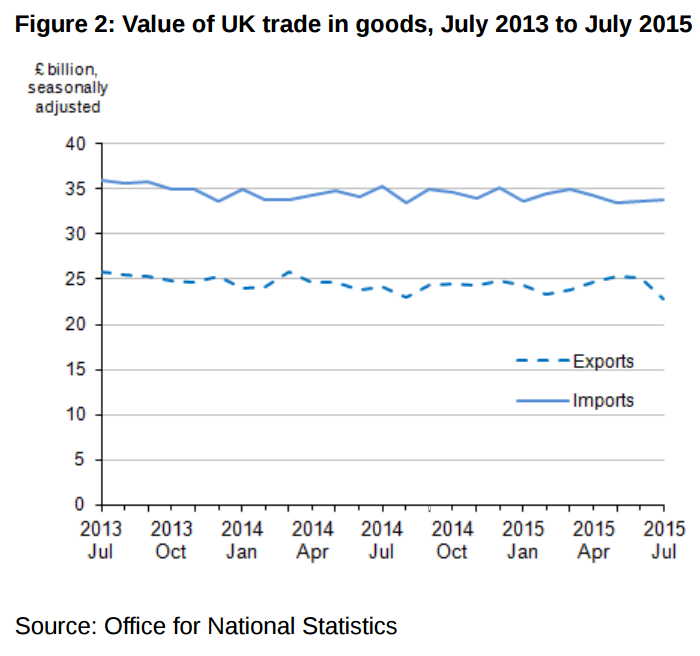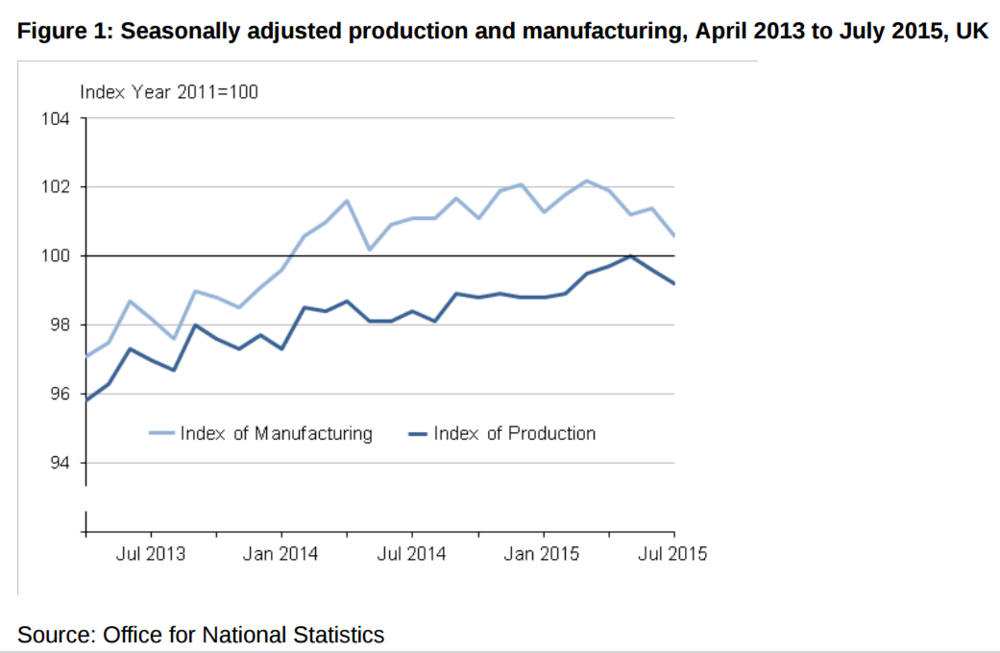Total production output decreased by 0.4% in July 2015 compared with June. Manufacturing (by far the largest sector) fell by 0.8% – the largest fall since May 2014. Mining and quarrying increased slightly but within this, oil and gas extraction fell a little (for a second month). Supply of electricity, gas, water, waste management etc. all rose.
Looking at the position compared to a year ago, total production output is estimated to have increased by 0.8% in July 2015 compared with July 2014. The largest positive contribution was from
mining & quarrying, which increased by 6.7% – mainly due to oil and gas extraction, which is up a big 9% over the year despite recent falls.
However, manufacturing output actually decreased by 0.5% in July 2015 compared with July 2014. This is a strong indication that the aim of having a more balanced economy is far from being realised. The largest contribution to the decrease came from the manufacture of machinery & equipment, down 15.9%.
Taking the last 3 months to July 2015 compared to the same months in 2014, total production is up 1.4%, due heavily to the increase in oil and gas production. Manufacturing is up just 0.4% over the year, far below the rate of increase in GDP as a whole.
For the 3 months to July 2015, production and manufacturing were down 9.3% and 5.2% respectively from the pre-crisis GDP peak in Quarter 1 2008.
July trade figures
The UK’s deficit on trade in goods and services was estimated at £3.4 billion in July 2015, a widening of £2.6 billion compared with June. This is due to an increased deficit in goods, up from £8.5 billion in June to £11.1 billion in July.
Exports of goods decreased by £2.3 billion to £22.8 billion in July, the lowest export figure since September 2010. This is due in particular to decreases in semi-manufactures (notably chemicals) of £1.0 billion and finished manufactures of £0.8 billion.
Imports of goods increased by £0.3 billion to £33.9 billion over the same period.
However, one month figures are not always indicative a bigger trend – it is preferable also to look at the quarterly position.
In the 3-months to July 2015, the UK’s deficit on trade in goods and services was estimated to have been £4.7 billion; narrowing by £4.1 billion when compared with the 3-months to April 2015. Thus the July figures have fallen a long way back from a more positive position in recent months.
In the 3-months to July 2015, the trade in goods deficit narrowed by £3.8 billion to £27.8 billion.
Exports increased by £1.2 billion to £73.2 billion, and imports decreased by £2.6 billion to £101.0 billion over the same period.
The decrease in imports for the 3-months to July 2015 is due to a £2.5 billion decrease in non-EU imports, the lowest 3-monthly non-EU import figure since June 2010. This results from decreases in finished manufactures of £1.4 billion, and semi-manufactures of £0.4 billion.
In the 3-months to July 2015, the trade in services surplus widened by £0.3 billion to £23.0 billion, with an increase of £0.1 billion in exports and a decrease of £0.1 billion in imports.
Excluding oil, in July exports fell by almost £2 billion, or 8.6% compared to June, while imports increased by £568 million (1.8%). Again, the 3 month figures are less severe – exports fell 0.2% compared to the previous 3 months, while imports fell by a bigger 2.5%. Year on year, however, exports of goods excluding oil rose by a reasonably healthy 3.9%, while imports dipped slightly.





